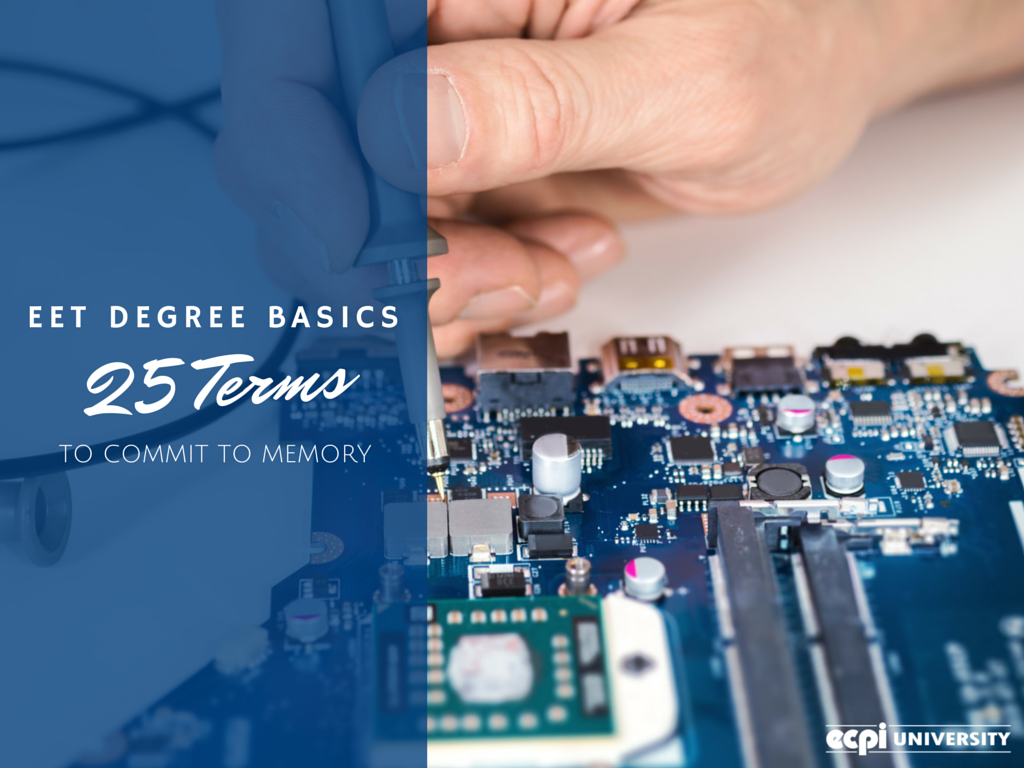
Ever listen to engineers and techs talking shop? You'll hear words like "quantization" and "baselines." You may struggle to figure out what they mean by "gain" and "amperes." The electrical engineering technology field uses specific language that can sound strange to those not in-the-know. As technology advances, the lingo develops and evolves. From computer networking to cell phones to broadcasting, knowing the job-specific vocabulary of electrical engineering technology is increasingly important.
To get a head start on understanding the language, here are 25 electronics engineering technology terms you should commit to memory:
- Alternating Current (AC)
Commonly found in homes, AC is electric current that reverses directions at regular intervals.
- Ampere
The symbol of ampere is "I" and it denotes a unit of measurement for the intensity of the flow of electricity.
- Analog
This is a system where an electrical value is representative of something in the physical world.
- Bare Conductor
A conductive wire or cable without any insulation.
- Baseline
Sometimes called the output at no-load condition, this is the electrical signal when no variables are present.
- Broadband
A transmission medium to carry many video, voice or data channels at once.
- Current
Current can be either AC or DC, and denotes the flow of electricity through a circuit.
- Circuit
This is the flow of electricity through multiple wires from a supply to at least one outlet, and then back again.
- Circuit Breaker
This is a safety device that breaks the flow of electricity. This is done as an emergency break in case of overloading. It can also be opened or closed manually.
- Conductor
A material that can convey an electric current. For example, in a home, copper wire is often used as a conductor.
- Diode
This is a two-terminal device that passes current in just one direction.
- Direct Current (DC)
This is when an electric current flows only in one direction. This is more likely to be found in industrial settings rather than homes.
- Frequency
The amount of periods per unit of time in cycles per second, or Hertz.
- Fuse
A device used for safety that cuts the flow of electricity when the current exceeds its capacity.
- Gain
In an amplifier circuit, this is the amount of amplification accomplished.
- Impedance
In an AC circuit, this is a measurement of the resistant and reactive attributes of a component.
- Joule
Abbreviated "J" this is a measurement of energy. In electronics it is the electric equivalent of a "newton" in mechanical systems. One joule is one watt of power applied for a single second.
- Neutral Wire
The third wire in a three-wire distribution circuit, it is connected to the ground.
- Quantization
This is where a continuous range of input-signal values are divided into sub-ranges that do not overlap.
- Resistance
This is the restriction of the flow of current, measured in Ohm. The lower the resistance, the more current flows.
- Short Circuit
This is when there is a stoppage in the flow of electricity due to a fault of slight impedance between conductors that are active.
- Voltage Drop
When current travels through a cord, the voltage decreases at a given rate over the distance. The longer the distance, the greater the drop.
- Volt
The measurement of electrical force, also known as electromotive force, it is symbolized as either "E" or "V".
- Volt-Ampere
This is a measurement of power in a direct current electrical circuit. Its symbol is "VA".
- Watts
This is a unit of electric power. The formula for finding watt is: Volts times Amperes equals Watts.
Just picked up my regalia. It's setting in now. #ElectricalEngineer #graduation @ ECPI College of… http://t.co/u32GXir9rT
— Ash (@OatzTheGreat) June 4, 2014
Become an Electronics Engineering Technologist
Want to learn more about this exciting field? Consider ECPI University. Through its year-round program, you can earn a Bachelor of Science Degree in Electronics Engineering Technology in just 2.5 years or an Associate’s degree in just 1.5 years. Contact ECPI University today. It could be the Best Decision You Ever Make!
DISCLAIMER – ECPI University makes no claim, warranty or guarantee as to actual employability or earning potential to current, past or future students or graduates of any educational program we offer. The ECPI University website is published for informational purposes only. Every effort is made to ensure the accuracy of information contained on the ECPI.edu domain; however, no warranty of accuracy is made. No contractual rights, either expressed or implied, are created by its content.
For more information about ECPI University or any of our programs click here: http://www.ecpi.edu/ or http://ow.ly/Ca1ya.


